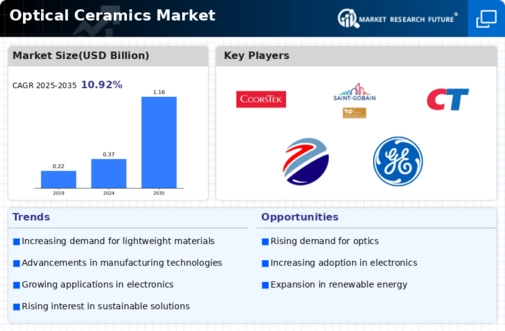Top Industry Leaders in the Optical Ceramics Market
 The optical ceramics market, shimmering with promise, is attracting an array of players eager to stake their claim in this rapidly expanding domain. These advanced materials, with their exceptional transparency, thermal stability, and mechanical strength, are illuminating an array of applications, from laser technology to aerospace components. But navigating this competitive landscape, rife with established giants and nimble startups, demands a keen understanding of the strategies at play, the factors driving market share, and the recent developments shaping the field.
The optical ceramics market, shimmering with promise, is attracting an array of players eager to stake their claim in this rapidly expanding domain. These advanced materials, with their exceptional transparency, thermal stability, and mechanical strength, are illuminating an array of applications, from laser technology to aerospace components. But navigating this competitive landscape, rife with established giants and nimble startups, demands a keen understanding of the strategies at play, the factors driving market share, and the recent developments shaping the field.
Factors Dictating Market Dominance: A Kaleidoscope of Influences
Several key factors are orchestrating the dance for market share:
-
Technological Advancements: Innovation is the beating heart of this market. Continuous improvements in manufacturing processes, material properties, and integration techniques are lowering costs, expanding applications, and fueling growth. -
Application Diversity: Optical ceramics are transcending their niche origins. From aerospace and defense to medical imaging, telecommunications, and even consumer electronics, the range of potential applications is staggering, offering fertile ground for market expansion. -
Regional Dynamics: Asia Pacific, particularly China and Japan, is leading the charge with robust government initiatives and booming industrial sectors. However, Europe and North America are also witnessing significant growth, propelled by technological advancements and increasing awareness of optical ceramics' advantages. -
Sustainability Drive: The push for eco-friendly materials is resonating with consumers and industries alike. Optical ceramics, often boasting lower environmental impact compared to traditional options, are finding favor in this green wave, further influencing market share.
Strategies for Shining Bright: Illuminating the Path to Success
Market leaders are wielding a potent arsenal of strategies to outshine their rivals:
-
Vertical Integration: Securely controlling the supply chain, from raw materials to finished products, is a key tactic employed by companies like CoorsTek and Surmet. This ensures quality, cost control, and agility in a rapidly evolving market. -
Product Diversification: Offering a broad portfolio of optical ceramics tailored to specific applications is crucial. Companies like CeraNova and Schott are leading the charge in developing novel material compositions and specialized products to cater to diverse needs. -
Strategic Partnerships: Collaboration with research institutions, universities, and end-user industries fosters innovation and accelerates application development. This collaborative approach is being championed by companies like II-VI Optical Systems and Saint-Gobain. -
Global Expansion: Building a strong international presence is vital for long-term success. Companies like Konoshima Chemicals and Shanghai SICCAS are establishing manufacturing facilities and distribution networks across continents to tap into global demand.
Key Companies in the Optical Ceramics market include
- Surmet Corporation (US)
- CoorsTek Inc. (US)
- Konoshima Chemicals Co. Ltd (Japan)
- Saint-Gobain (France)
- CeramTec (Germany)
- Murata Manufacturing Co. Ltd (Japan)
- CeraNova (US)
- Schott AG (Germany)
- Shanghai SICCAS (China)
- Kyocera Corporation (Japan)
- II-VI Optical Systems Inc. (US)
- Brightcrystals Technology Inc. (China)
- CILAS Arianegroup (France)
- General Electric (US)
- Koninklijke Philips N.V. (Netherlands)
Recent Developments:
-
September 2023: Bright Crystals Technology, a rising startup, unveils a novel manufacturing process for ultra-pure optical ceramics, potentially disrupting the established production methods. -
October 2023: CoorsTek and Shanghai SICCAS partner to develop and commercialize transparent ceramic armor for military and law enforcement applications, showcasing the material's potential for enhanced protection. -
November 2023: Researchers at MIT demonstrate the successful integration of optical ceramics in high-efficiency solar cells, potentially revolutionizing the photovoltaic industry. -
December 2023: A team at Stanford University reports the creation of a biocompatible optical ceramic for medical implants, opening doors for next-generation prosthetics and biosensors.

